NASA awards $415 mn to fund three commercial space stations
Friday, 03 December 2021 00:06 NASA on Thursday awarded three companies hundreds of millions of dollars to develop commercial space stations it hopes will eventually replace the International Space Station, which is due to retire around the end of the decade.
Jeff Bezos' Blue Origin, aerospace company Nanoracks, and defense contractor Northrop Grumman won $130 million, $160 million and $125.6 million contracts respectivel
NASA on Thursday awarded three companies hundreds of millions of dollars to develop commercial space stations it hopes will eventually replace the International Space Station, which is due to retire around the end of the decade.
Jeff Bezos' Blue Origin, aerospace company Nanoracks, and defense contractor Northrop Grumman won $130 million, $160 million and $125.6 million contracts respectivel NASA selects companies to develop commercial destinations in space
Friday, 03 December 2021 00:06 NASA has signed agreements with three U.S. companies to develop designs of space stations and other commercial destinations in space. The agreements are part of the agency's efforts to enable a robust, American-led commercial economy in low-Earth orbit.
The total estimated award amount for all three funded Space Act Agreements is $415.6 million. The companies that received awards are:
NASA has signed agreements with three U.S. companies to develop designs of space stations and other commercial destinations in space. The agreements are part of the agency's efforts to enable a robust, American-led commercial economy in low-Earth orbit.
The total estimated award amount for all three funded Space Act Agreements is $415.6 million. The companies that received awards are: Nanoracks led team want to build a commercial space station
Friday, 03 December 2021 00:06 Nanoracks, in collaboration with Voyager Space and Lockheed Martin, has been awarded a $160 million contract by NASA to design its Starlab commercial space station as part of the agency's Commercial Low-Earth Orbit (LEO) Development program. Starlab will enable NASA's initiative to stimulate the commercial space economy and provide science and crew capabilities prior to the retirement of the Int
Nanoracks, in collaboration with Voyager Space and Lockheed Martin, has been awarded a $160 million contract by NASA to design its Starlab commercial space station as part of the agency's Commercial Low-Earth Orbit (LEO) Development program. Starlab will enable NASA's initiative to stimulate the commercial space economy and provide science and crew capabilities prior to the retirement of the Int Sols 3314-3315: Bountiful, Beautiful Boulders!
Friday, 03 December 2021 00:06 The engineers at JPL responsible for driving Curiosity yet again delivered a perfect drive to some boulders that the science team have been interested in investigating. The large boulders are thought to represent the darker, resistant rocks exposed just above us that cap the underlying less resistant, lighter coloured rocks we have been driving over.
The caprocks and boulders both show t
The engineers at JPL responsible for driving Curiosity yet again delivered a perfect drive to some boulders that the science team have been interested in investigating. The large boulders are thought to represent the darker, resistant rocks exposed just above us that cap the underlying less resistant, lighter coloured rocks we have been driving over.
The caprocks and boulders both show t Bolstering planetary biosecurity in an era of space exploration
Friday, 03 December 2021 00:06 The search of life beyond our world is an exciting venture that may yield an enormous discovery in the not-too-distant future. However, space agencies around the world, including NASA and the European Space Agency, have long been aware of the potential risks of biological contamination and have set in place planetary protection policies. In the face of increasing space missions, including those
The search of life beyond our world is an exciting venture that may yield an enormous discovery in the not-too-distant future. However, space agencies around the world, including NASA and the European Space Agency, have long been aware of the potential risks of biological contamination and have set in place planetary protection policies. In the face of increasing space missions, including those An eight-hour year
Friday, 03 December 2021 00:06 As far as extrasolar planets go, 'GJ 367 b' is a featherweight. With half the mass of Earth, the newly discovered planet is one of the lightest among the nearly 5000 exoplanets known today. It takes the extrasolar planet approximately eight hours to orbit its parent star. With a diameter of just over 9000 kilometres, GJ 367 b is slightly larger than Mars.
The planetary system is located ju
As far as extrasolar planets go, 'GJ 367 b' is a featherweight. With half the mass of Earth, the newly discovered planet is one of the lightest among the nearly 5000 exoplanets known today. It takes the extrasolar planet approximately eight hours to orbit its parent star. With a diameter of just over 9000 kilometres, GJ 367 b is slightly larger than Mars.
The planetary system is located ju SpaceX breaks annual launch record as it deploys 48 more Starlink satellites
Friday, 03 December 2021 00:02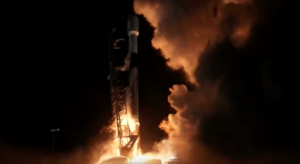
SpaceX deployed 48 more satellites for its Starlink broadband constellation Dec. 2, along with two remote sensing spacecraft for BlackSky in a mission that breaks the record for Falcon 9 launches in a calendar year.
Spacewalking astronauts replace antenna after debris scare
Thursday, 02 December 2021 16:26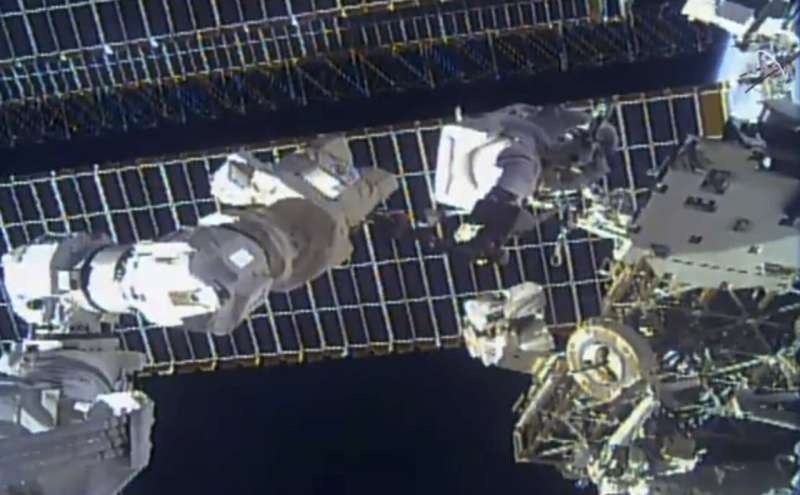
Spacewalking astronauts replaced a broken antenna outside the International Space Station on Thursday after getting NASA's all-clear for orbiting debris.
U.S. astronauts Tom Marshburn and Kayla Barron were supposed to complete the job Tuesday, but NASA delayed the spacewalk because of potentially threatening space junk. NASA later determined the astronauts were safe to go out, despite a slightly increased risk of a punctured suit from satellite wreckage.
Rocket Lab updates Neutron design
Thursday, 02 December 2021 15:57
Rocket Lab released new details Dec. 2 of the design of its Neutron medium-class rocket, a vehicle with a unique design the company says is intended to enable frequent and low-cost reuse.
Two versions of a Curiosity selfie: narrow and wide
Thursday, 02 December 2021 13:49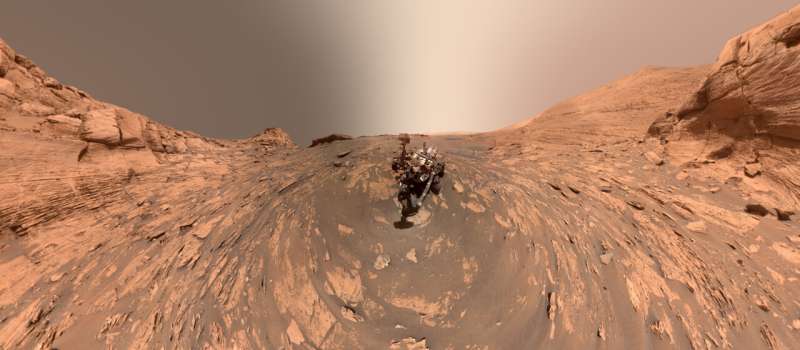
NASA's Curiosity Mars rover took this 360-degree selfie using the Mars Hand Lens Imager, or MAHLI, at the end of its robotic arm. The selfie comprises 81 individual images taken on Nov. 20, 2021—the 3,303rd Martian day, or sol, of the mission.
The rock structure behind the rover is "Greenheugh Pediment"; the hill that is middle distance on the right, is "Rafael Navarro Mountain." Curiosity is headed toward "Maria Gordon Notch," the U-shaped opening behind the rover to the left.

Explore further
A one-way phone call from Mars
Thursday, 02 December 2021 13:47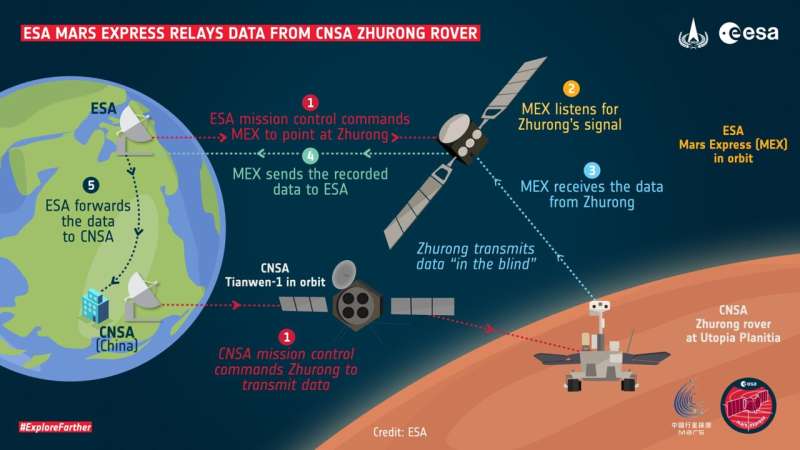
This November, ESA's Mars Express spacecraft carried out a series of experimental communication tests with the Chinese (CNSA) Zhurong Mars rover. Mars Express successfully caught data sent up 'in the blind' by the rover and relayed them to Earth where they were forwarded to the Zhurong team in China.
13:07 CET, 7 November, Utopia Planitia. The Zhurong rover, commanded by the Tianwen-1 orbiter, points its radio up at the Martian sky. Any minute now, ESA's Mars Express will begin to pass overhead. Zhurong starts transmitting a signal up into space. It has no way of knowing if its message is being received.
Landers and rovers on Mars gather data that help scientists answer fundamental questions about the geology, atmosphere, surface environment, history of water and potential for life on the Red Planet.
To get these insights to Earth, they first transmit the data up to spacecraft in orbit around Mars. These orbiters then use their much larger, more powerful transmitters to 'relay' the data across space to Earth.
"Normally, an orbiter like ESA's Mars Express first sends down a hail signal to a rover as a 'hello,'" says James Godfrey, Mars Express Spacecraft Operations Manager.
AFRL selects 10 universities for satellite program
Thursday, 02 December 2021 13:02 The Air Force Research Laboratory's University Nanosatellite Program (UNP) has selected 10 universities to participate in the upcoming 2-year partnership to design, fabricate and test small satellites.
At the recent Flight Selection Review for the program's tenth cycle, 3 of 10 universities were chosen to remain in the program and continue development of their CubeSats. These universities
The Air Force Research Laboratory's University Nanosatellite Program (UNP) has selected 10 universities to participate in the upcoming 2-year partnership to design, fabricate and test small satellites.
At the recent Flight Selection Review for the program's tenth cycle, 3 of 10 universities were chosen to remain in the program and continue development of their CubeSats. These universities DLR inaugurates its Institute for the Protection of Terrestrial Infrastructures
Thursday, 02 December 2021 13:02 Everyday life in an increasingly digitalised and connected world depends on functioning infrastructure. The economy and public life would quickly break down without working power grids, water supplies, hospitals and transport networks. The new German Aerospace Center (Deutsches Zentrum fur Luft- und Raumfahrt; DLR) Institute for the Protection of Terrestrial Infrastructures, located in Sankt Aug
Everyday life in an increasingly digitalised and connected world depends on functioning infrastructure. The economy and public life would quickly break down without working power grids, water supplies, hospitals and transport networks. The new German Aerospace Center (Deutsches Zentrum fur Luft- und Raumfahrt; DLR) Institute for the Protection of Terrestrial Infrastructures, located in Sankt Aug US Space Force raises alarm over China's orbital hypersonic weapons
Thursday, 02 December 2021 13:02 The Pentagon suggests that China tested a fractional orbital bombardment system (FOBS) earlier this year. According to US military observers, China's alleged new orbital hypersonic glide vehicle weapon poses a huge challenge to the Pentagon since the US does not have active countermeasures to these arms.
China's new hypersonic weapon system is orbital in nature and could be able to stay in
The Pentagon suggests that China tested a fractional orbital bombardment system (FOBS) earlier this year. According to US military observers, China's alleged new orbital hypersonic glide vehicle weapon poses a huge challenge to the Pentagon since the US does not have active countermeasures to these arms.
China's new hypersonic weapon system is orbital in nature and could be able to stay in 

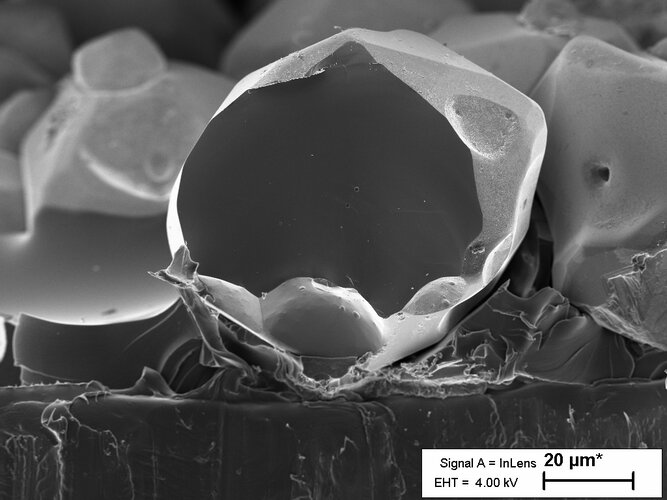 Image:
Tiny crystal of power
Image:
Tiny crystal of power